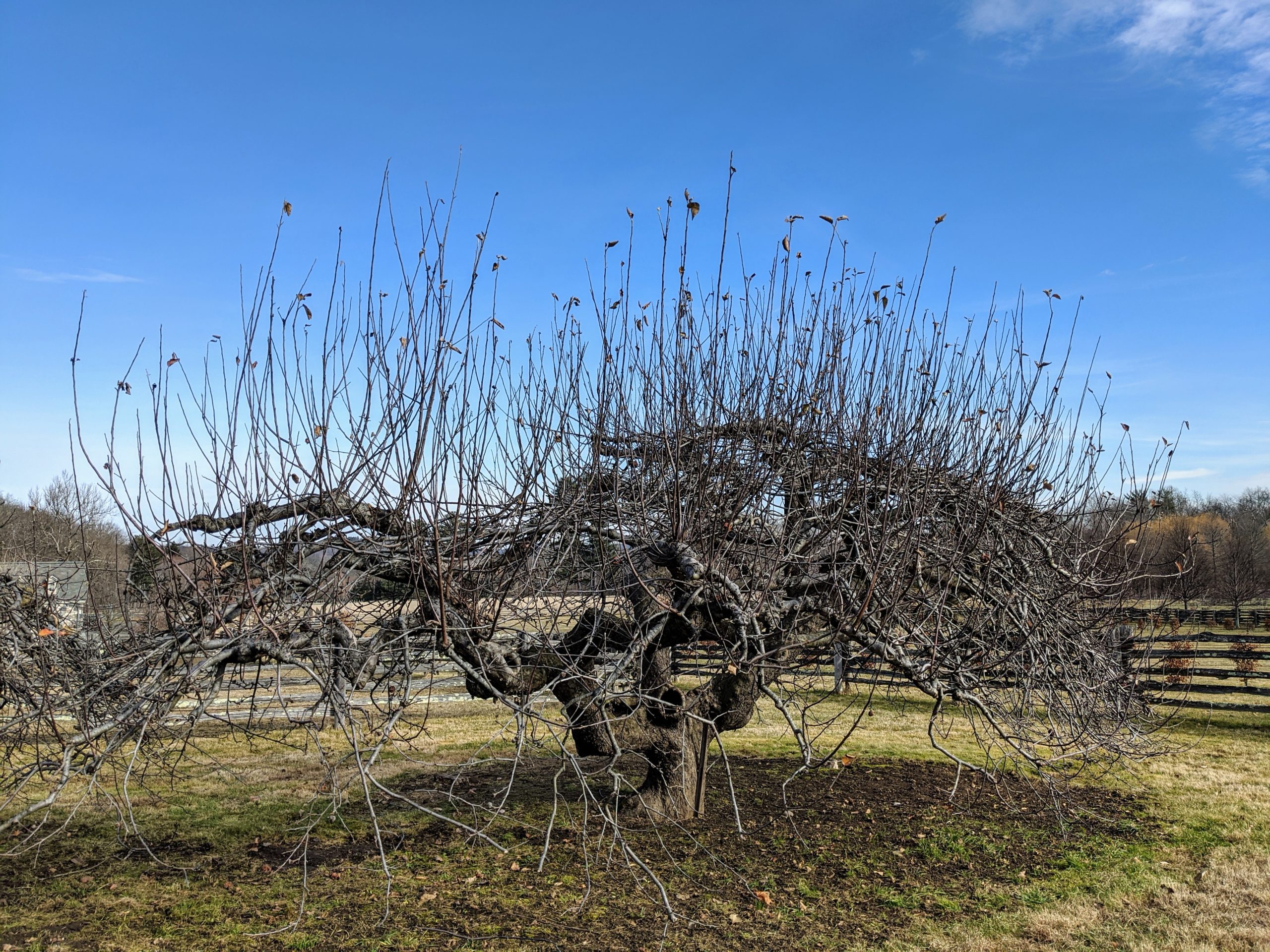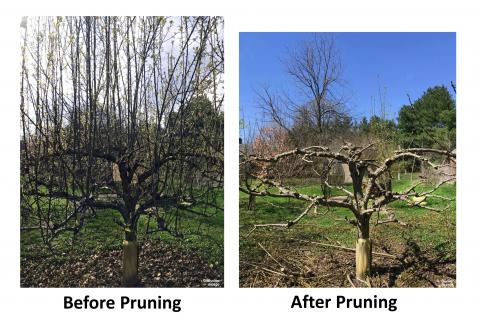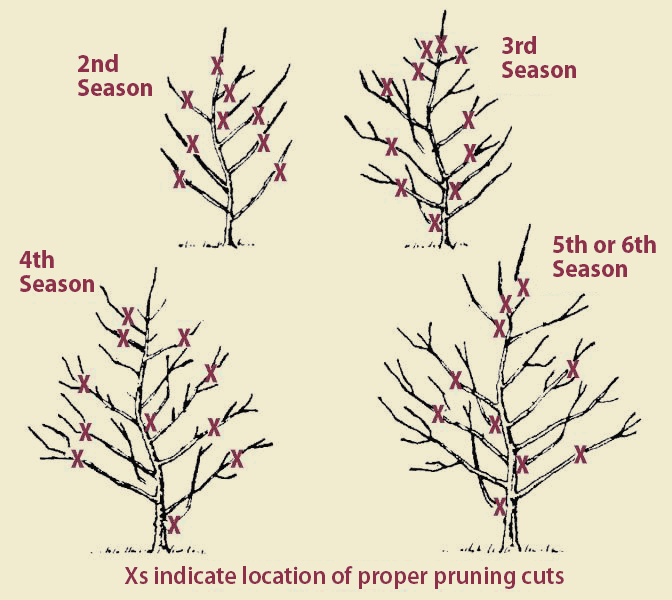To prune apple trees, start by removing dead or diseased branches and shaping the tree for proper air circulation. Pruning in late winter stimulates healthy growth and increased fruit production.
Apple trees provide a bountiful harvest of delicious fruits, but proper pruning is essential to maintain their health and productivity. Pruning also helps to improve sunlight penetration and airflow within the tree canopy, reducing the risk of disease. By following the correct pruning techniques, you can ensure that your apple trees thrive and yield abundance for years to come.
In this guide, we will discuss the essential steps and tips for effectively pruning apple trees to promote optimal growth and fruit production. Let’s delve into the art of pruning apple trees to help you achieve a successful harvest season.

Credit: www.themarthablog.com
Choosing The Right Time
Pruning an apple tree at the right time is essential for promoting healthy growth and fruit production. Proper timing can prevent disease and damage while encouraging the tree to flourish. In this section, we will explore the crucial aspects of timing to ensure that your apple tree pruning is both effective and beneficial.
Understanding The Importance Of Timing
Timing is crucial when it comes to pruning apple trees. Pruning at the right time allows the tree to heal quickly and reduces the risk of disease or stress. Improper timing can lead to vulnerability to pests and weather damage, impacting the overall health of the tree.
Identifying The Best Season For Pruning
The best season for pruning apple trees is during late winter to early spring. This period is ideal because the tree is dormant and less susceptible to stress from pruning. Late winter pruning allows the wounds to heal before the growing season begins, promoting healthy regrowth and reducing the risk of infections.

Credit: extension.illinois.edu
Tools And Equipment
When it comes to pruning your apple trees, having the right tools and equipment is crucial for the job. You need to ensure you have the essential tools in hand and keep them well-maintained to make the pruning process smooth and effective.
Essential Tools For Apple Tree Pruning
- Pruning Shears: Sharp shears for cutting small branches and twigs.
- Loppers: For thicker branches that pruning shears cannot handle.
- Pruning Saw: Ideal for cutting larger branches with precision.
- Gloves: Protects your hands from scratches and cuts.
- Safety Goggles: Essential for eye protection when cutting branches.
Maintaining And Sharpening Your Tools
- Keep Tools Clean: Wipe down tools after each use to prevent sap buildup.
- Oil Moving Parts: Regularly lubricate tools to keep them functioning smoothly.
- Sharpen Blades: Regularly sharpen pruning shears and saw blades for clean cuts.
- Replace Worn-Out Parts: Replace any damaged or worn-out parts of your tools for efficiency.
Pruning Techniques
Learn the essential techniques for pruning apple trees to maintain their health and promote optimal fruit production. Discover the proper methods for shaping the branches, removing dead wood, and fostering new growth.
Removing Dead And Diseased Branches
Apple trees should be pruned to remove dead or diseased branches, which can harm the tree.Creating A Strong Scaffold Structure
Focusing on creating a strong scaffold structure ensures a better shape and healthier tree for optimal fruit production.Encouraging Fruit Production
Encouraging fruit production is essential for a bountiful harvest. Regular pruning supports the growth of healthy fruit.Step-by-step Pruning Process
Evaluating Your Tree’s Health And Shape
Before taking any action, evaluate the overall health and shape of your apple tree. Look for signs of disease, damage, or excessive growth that may need attention. Assess the structure of the branches and the overall balance of the tree’s canopy.
Making The Initial Cuts
When making initial cuts, start by removing any dead, diseased, or damaged branches. Use sterilized pruning shears to make clean cuts close to the branch collar, a slight swelling where the branch connects to the trunk or another limb. Trim any crossing or rubbing branches as well to open up the canopy.
Thinning Out Excess Branches
Next, focus on thinning out the excess branches to improve air circulation and sunlight penetration. Selectively prune to maintain a balanced structure, removing crowded or inward-growing branches. Aim to create an open and well-spaced canopy to promote fruit production and overall tree health.
Finalizing The Pruning Process
Finally, finalize the pruning process by stepping back and assessing the overall shape and balance of the tree. Make any necessary final cuts to achieve the desired form and ensure the tree’s long-term health and productivity. Remember to step back periodically to view your progress from a distance and make adjustments as needed.
Caring For Pruned Apple Trees
To care for pruned apple trees, always ensure you prune at the right time and use proper techniques. Regularly check for any signs of disease or pests, and provide adequate support to encourage healthy growth. Apply a balanced fertilizer and maintain proper watering to keep the trees thriving.
Applying Pruning Sealant
After pruning your apple trees, it is important to take steps to protect the freshly cut surfaces from potential pests and diseases. Applying a pruning sealant acts as a barrier against harmful organisms, preventing them from entering the wounds and causing damage.
To apply the pruning sealant, follow these simple steps:
- Clean the pruned areas by removing any debris or loose bark with a soft brush.
- Make sure the surface of the cuts is smooth and clean.
- Using a paintbrush, apply a thin layer of pruning sealant over the cut surfaces.
- Allow the sealant to dry completely before touching or manipulating the pruned areas.
By applying a pruning sealant, you provide an extra layer of protection to promote the healing process and enhance the tree’s ability to ward off potential diseases.
Mulching And Fertilizing
Proper mulching and fertilization are crucial for the growth and overall health of your pruned apple trees. Mulching helps retain moisture, suppress weed growth, and regulate soil temperature, while fertilization provides essential nutrients for the tree’s development.
Consider the following guidelines for mulching and fertilizing:
- Spread a layer of organic mulch around the base of the tree, keeping it a few inches away from the trunk. This helps prevent the growth of weeds and conserves soil moisture.
- When choosing fertilizers, opt for slow-release or organic options that provide balanced nutrients. Consult with a local horticulturist or extension service to determine the best fertilizer for your specific apple tree variety.
- Apply the recommended amount of fertilizer based on the package instructions. Avoid over-fertilizing, as this can lead to excessive foliage growth without promoting fruit production.
- During the growing season, periodically check the moisture level of the soil and water as necessary to keep it consistently moist.
By mulching and fertilizing your pruned apple trees, you ensure they receive the necessary nutrients and create an optimum growing environment for a bountiful harvest.
Monitoring And Maintaining Tree Health
Ongoing monitoring and maintenance are essential to keep your pruned apple trees healthy and thriving. Regular inspections allow you to identify and address any potential issues promptly, ensuring the longevity and productivity of your trees.
Here are some tips for monitoring and maintaining the health of your pruned apple trees:
- Regularly inspect the tree for signs of pests, diseases, or nutrient deficiencies. Look for wilting leaves, discoloration, unusual growths, or insect activity.
- If any issues are detected, consult with a local arborist or extension service for appropriate treatment options.
- Prune any additional branches or shoots that emerge after the initial pruning, ensuring they follow the proper shape and structure.
- Monitor the overall growth and development of the tree, making note of any changes or abnormalities.
By diligently monitoring and maintaining the health of your pruned apple trees, you can catch any problems early on and take the necessary steps to preserve their well-being and productivity.
Credit: www.thespruce.com
Frequently Asked Questions For How To Prune Apple Trees
What Is The Best Month To Prune Apple Trees?
The best month to prune apple trees is late winter or early spring before new growth starts.
How Do You Prune An Apple Tree Step By Step?
To prune an apple tree, start by removing dead or diseased branches. Trim back excessive growth. Cut at a 45-degree angle above outward-facing buds. Maintain an open center shape for sunlight and air circulation, improving fruit production. Apply pruning seal to cuts larger than a pencil.
What Not To Do When Pruning Apple Trees?
When pruning apple trees, avoid cutting too much at once to prevent stress and disease. Do not prune during the growing season, as it can harm the tree. Avoid leaving sharp, uneven cuts, and never prune in wet conditions. Lastly, refrain from neglecting to sterilize tools between trees to prevent the spread of diseases.
How Do You Prune A Large Overgrown Apple Tree?
To prune a large overgrown apple tree, start by removing dead or damaged branches. Then, cut back any crossing or rubbing branches to improve air circulation. Additionally, thin out crowded areas to allow sunlight to reach all parts of the tree.
Finally, make sure to shape the tree by cutting back excessive growth.
Conclusion
Learning how to prune apple trees is essential for maximizing fruit production and overall tree health. By following the proper techniques and timing, you can enhance the beauty and productivity of your orchard. With regular maintenance and care, your apple trees will thrive and provide bountiful harvests for years to come.


